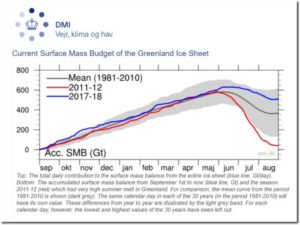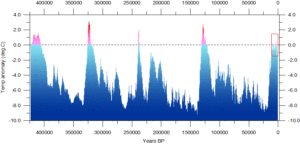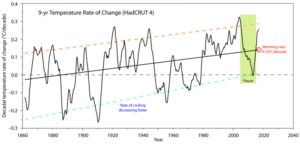by P. Homewood, September 3, 2018, in NotaLotofPeopleKnowThat
Global temperatures fell back to 0.19C in August. This means the YTD average is 0.23C, putting them back to roughly where they were in 2002.
…
by P. Homewood, September 3, 2018, in NotaLotofPeopleKnowThat
Global temperatures fell back to 0.19C in August. This means the YTD average is 0.23C, putting them back to roughly where they were in 2002.
…
by GWPF, September 4, 2018
These ‘Conferences of the Parties’, or COPs as they are usually termed, involve all of the members of the United Nations Framework Convention on Climate Change and take place towards the end of the year. This year will see the 24th COP take place in Katowice, Poland.
Over the years the COPs have developed a style all of their own. Indeed, some observers have even gone as far as to suggest that each year sees less and less by way of meaningful activity, and more and more liturgy and ritual.
They may just have a point as our historical review reveals.
by Andy May, September 18, 2018 WUWT
In Part A of the Great Debate series (see here) we discussed Dr. David Karoly’s and Dr. William Happer’s arguments regarding how unusual recent global warming is and how we know the recent observed increase in CO2 is due to human activities. In Part B we examined their thoughts on the amount of warming caused by greenhouse gas emissions and the accuracy of the calculation. In Part C we discussed the dangers of global warming, the calculation of the vital value of ECS (the equilibrium climate sensitivity to a doubling of CO2), and discuss the need to do something about climate change. In this final part of the series I will summarize the debate and provide my thoughts.
…
by Andy May, September 3, 2018, in WUWT
In Part A of the Great Debate series (see here) we discussed Dr. David Karoly’s and Dr. William Happer’s arguments regarding how unusual recent global warming is and how we know the recent observed increase in CO2 is due to human activities. In Part B we examined their thoughts on questions three and four. Number 3 is “How do we know that the increase in CO2 and other greenhouse gases in the atmosphere have caused most of the recent global warming?” Number 4 is “Climate models have been used to compute the amount of warming caused by human activities, how accurate are they?”
For an introduction to the debate and links to the original documents see Part A. In Part C we will examine the predictions that global warming and more CO2 are dangerous and that we (as a global society) need to do something about it.
…
by Andy May, September 2, 2018 in WUWT
In Part A of the Great Debate series (see here) we discussed Dr. David Karoly’s and Dr. William Happer’s arguments regarding how unusual the recent global warming is and how we know the recent observed increase in CO2 is due to human activities. In Part B we will examine their thoughts on questions three and four.
3. How do we know that the increase in CO2 and other greenhouse gases in the atmosphere have caused most of the recent global warming?
4. Climate models have been used to compute the amount of warming caused by human activities, how accurate are they?
For an introduction to the debate and links to the original documents see Part A.
…
by JC Dupont, 3 septembre 2018
Quelques commentaires sur quelques commentaires
La Lettre d’information 7 sort légèrement du cadre prévu à l’origine pour ces Lettres. Elle se rapporte à des commentaires qu’elles ont suscités et qui sont parus dansL’1Dex. L’1Dex est un média alternatif valaisan, dont le motto est « Pour un Valais
critique et libertaire ». Grâce au libéralisme de son rédacteur en chef, Me Stéphane Riand, et de son équipe dirigeante, les voix discordantes, les pensées de contre-courant, les points de vue tenus pour hérétiques, tout ce qui se heurte aux interdits des presses bien-pensantes, peuvent se faire entendre. De l’air frais sur la « Panurgie ». C’est ainsi que mes Lettres d’information ont connu une diffusion inespérée. L’1Dex offre aussi à ses lecteurs la possibilité de réagir avec des commentaires, qui sont le plus souvent anonymes. L’ignorance générale où l’on est des questions relatives au climat, ajoutée à l’illusion qu’un consensus se serait établi parmi les scientifiques, comme on le laisse entendre dans les milieux de la climatologie officielle, expliquent la cacophonie et la variété ébouriffante de certains de ces commentaires. Pour des raisons que j’expose plus loin, je ne m’y suis guère arrêté jusqu’ici. De par le contexte même, le contenu de la présente Lettre est plus local. Néanmoins, on passe à la généralité par des extrapolations simples.
….
by Larry Bell, September 3, 2018 in Newsmax
New evidence now updates and confirms a column I wrote in June 2014 that some or all of the highly publicized melting of western coastal Antarctic glaciers may be caused by seabed volcanoes rather than having much or anything to do with climate change.
An article published in June 22 edition of the journal Nature Communications reports that an international team of scientists tracing a chemical signature of helium in the seawater discovered that contemporary volcanic heat is causing observed melting beneath the massive west Antarctic Ice Sheet (WAIS.)
by M. Ding et al., August 27, 2018 in CO2Science
…
The results of their analysis revealed that warming in this high Arctic site had proceeded at four times the global mean rate calculated in other data sets. However, Ding et al. note that over the last decade (2005-2014), “the warming rate in Ny-Ålesund slowed to 0.03 ± 1.85°C per decade,” which is essentially indicative of no-trend in the data. Lead-lag analysis further revealed that “Ny-Ålesund and global temperature variations were remarkably consistent, with a lag time of 8-9 years.” Consequently, the researchers say that “the ‘warming hiatus’ many scientists [have] studied also appears in Ny-Ålesund, it just started later than [that observed in] other areas.”
by Judith Curry, July 22, 2018 in ClimateEtc.
A remarkable essay by esteemed oceanographer Carl Wunsch.
While doing a literature survey for my paper on Climate Uncertainty and Risk, I came across a remarkable paper published in 2010 by MIT oceanographer Carl Wunsch, entitled Towards Understanding the Paleocean.
The paper is remarkable for several reasons — not only that it was published but that the paper was apparently invited by journal editor.
The paper is well worth reading in its entirety, for a fascinating perspective on paleo-oceanography and paleoclimatology. Here I provide excerpts of relevance to the sociology of climate science:
…
by David Whitehouse, August 30, 2018 in GWPF
Science is of course a human enterprise full of the imperfections of humanity. It’s more competitive than it’s ever been and there are more scientists than ever. So many want to communicate their science and this is wonderful. But the media, especially social media, can bring out a nasty streak in some especially when they take the moral high ground: ‘Some people should not be debated.’ ‘We are too right to be challenged.’ ‘Excommunicate!’
…
by F. Sotiropoulos, September 2018, in Stony Brook University/ published in Nature
The use of in-stream flow (or hydrokinetic) energy converters in rivers appears to offer another workable and effective option to expand renewable energy and limit carbon emissions in the United States. While the potential for in-stream flow energy harvesting systems has already been demonstrated for rivers with fixed beds, researchers now developed a scaled demonstration of hydrokinetic energy generated from a river channel with a sandy bed. Their findings, detailed in a new paper published in Nature Energy, showed that the model hydrokinetic power plant can generate energy effectively and safely without undermining the stability of the river geomorphic environment.
…
by P. Homewood, September 2, 2108 in NotaLofPeopleKnowThat
Something so extraordinary has lately been going on at the other end of the world that, if it did not run so flatly contrary to the prevailing groupthink of our time, it would surely have made big headlines over here.
We may have gathered that there has been something of an earthquake in the politics of Australia, where the prime minister Malcolm Turnbull faced such a revolt by his Cabinet colleagues over “climate change” that he was eventually forced out of office, to be replaced as leader by Scott Morrison.
But the real significance of this has only now come to light with the unveiling by Australia’s new energy minister, Angus Taylor, of the country’s wholly new energy policy, which completely reverses that of the Turnbull government.
…
by Claire Stam, 31 août 2018 in Euratciv/LaTribuneGenève
Alors qu’elle avoue la part de responsabilité de l’Allemagne dans le changement climatique, et carrément au passage, l’échec de la transition énergétique dans son pays, Angela Merkel s’est pourtant exprimée à la télé pour s’opposer aux objectifs climatiques plus ambitieux proposés par l’Union européenne qui cherche à trouver une solution face à un changement climatique de plus en plus rapide. Un article de notre partenaire Euractiv.
…
by P. Homewood, September 2, 2018 in NotaLotofPeopleKnowThat
Global temperatures fell back to 0.19C in August. This means the YTD average is 0.23C, putting them back to roughly where they were in 2002.
Arctic sea ice is tracking close to 2014, which finished with one of the highest minimums in the last decade. Current extent is well above the last three years.
by Andy May, September1 2018 in WUWT
February 15, 2016 was the beginning of an in-depth debate on man-made climate change between two well-known experts in the field, Dr. William Happer and Dr. David Karoly, hosted by TheBestSchools.org. Both have been heavily involved in atmospheric research since the 1980s, but they have landed on opposite sides of the debate.
…
Is recent global warming unusual?
How do we know the excess CO2, and other greenhouse gases, are from human activities?
How do we know that the increase in CO2 and other greenhouse gases in the atmosphere have caused most of the recent global warming?
Climate models have been used to compute the amount of warming caused by human activities, how accurate are they?
How do we know global warming and more CO2 will have substantial adverse impacts on humans and the planet?
Should anything be done to combat global warming?
by Paul Homewood, September 1, 208 in NotaLotofPeopleKnowThat
With one day to go, it is clear that 2018 has been one of the hottest summers on record for the UK, however, the margin between the mean temperatures at the top of the league tables (records dating back to 1910) is so small that at this point it is impossible to say if 2018 will be an outright winner. It is very close to the record-breaking summers of 2006 (15.78C), 2003 (15.77C), and 1976 (15.77C) all of which are within 0.01C of each other.
The margin is so small that different datasets and different regions of the UK will have different ranking. Usually we will only quote statistics to the nearest 0.1C as differences smaller than this could result from small numerical differences arising from the statistical calculations. A more comprehensive analysis of the 2018 summer data will be undertaken early next week and data for summer 2018 will continue to be analysed over the coming months.
…
by Météo Paris, 25 août 2018
Malgré des températures particulièrement élevées ces dernières semaines sur l’Hémisphère Nord, voire exceptionnelles sur l’Europe, le déclin des glaces de l’Arctique s’est vu ralenti.
Au 23 août, l’étendue des glaces de l’Arctique était d’approximativement 4.945 millions de kilomètres carrés. Des niveaux toujours particulièrement bas au regard de la moyenne observée sur la période 1981-2010 (6.866 millions de km2, soit un déficit de 28%). Néanmoins, ce niveau n’est « que » le 6e plus bas observé à cette date, très loin de la triste année 2012 (une superficie inférieure à 4 millions de km2 à la fin août). Une timide amélioration, puisque l’étendue de ces glaces avait alors été la 4e plus faible jamais observée sur l’ensemble du mois de juin.

Graphique de l’étendue des glaces de l’océan Arctique (en millions de km2) – Zachary Michael Labe
…
nb se reporter à la courbe rouge/see red curve
by Dr. S. Lüning and Prof. F. Vahrenholt, August 31, 2018 in NoTricksZone
The playbook is well-known: After a drought, heat wave or flood occurs, journalists and climate alarmists fall all over themselves in the race to issue shrill warnings that this is only the beginning and that it is known that evil climate change is behind it.
This summer of 2018 we experienced again a Central European heat wave. However the usual alarmists failed again to provide any solid statistics on the frequency of heat waves during the last 100 and 1000 years.
Here we are glad to help out by presenting the latest results on heat wave trend in North America. Let’s begin with a spring heat wave in the USA in 2012 which was examined by Dole & Hoerling (2014) within a long-term context. The authors see a purely natural cause behind the unusual heat:
…
by Tony Heller, August 31, 2018 in ClimateChangeDispatch
Summer is over, and Greenland’s surface has gained 510 billion tons of ice over the past year – about 40% above normal. The surface mass budget is snow/ice accumulation minus melt.
…
S
by Anthony Watts, August 30, 2018 in WUWT
Earth’s surface has undergone unprecedented warming over the last century, and especially in this century.
Every single year since 1977 has been warmer than the 20th century average, with 16 of the 17 warmest years on record occurring since 2001, and 2016 being the warmest year on recorded history. A study from 2016 found that without the emissions from burning coal and oil, there is very little likelihood that 13 out of the 15 warmest years on record would all have happened.
Source: https://www.ucsusa.org/global-warming/science-and-impacts/science/human-contribution-to-gw-faq.html
First a definition of the word “unprecedented”:
…
Note that “in this century” isn’t part of the definition. it says “never done or known before”
So in that spirit, here’s some other “unprecedented” warming in Earth’s history, via the Vostok Ice Core dataset:

…
by Anthony Watts, August 30, 2018 in WUWT
After nearly every hurricane, heatwave, drought, or other extreme weather event, commentators rush to link the disaster with climate change. But what does the science say?
In this fully revised and updated edition of Disasters & Climate Change, renowned political scientist Roger Pielke Jr. takes a close look at the work of the Intergovernmental Panel on Climate Change, the underlying scientific research, and the climate data to give you the latest science on how climate change is related to extreme weather.
What he finds may surprise you and raise questions about the role of science in political debates.
by Tony Heller, August 0, 2018 in ClimateChangeDispatch
The US had an unprecedented late summer heat wave from August 24 to September 6, 1953. The animation below shows the progression of the heat wave.
…
by Susan J. Crockford, August 29, 2018 in FinancialPost
It was tragedy porn meant to provoke a visceral response — the gut-wrenching video of an emaciated polar bear struggling to drag himself across a snowless Canadian landscape made billions of people groan in anguish. Taken in August 2017 by biologist Paul Nicklen, a co-founder of the Canadian non-profit SeaLegacy, the video was posted on Instagram in December 2017, stating “This is what starvation looks like” as part of a discussion about climate change.
…
by Javier, August 29, 2018 in WUWT
A no-assumptions look at the global warming evidence helps clarify the possibilities.
The planet’s surface has been warming since the depths of the Little Ice Age, and particularly since ~ 1850 AD. The surface temperature record, however incomplete or uncertain, reflects this warming. Hypotheses about why the warming is taking place can be grouped into three general categories:
A combination of these categories cannot be ruled out.
Whatever causes the temperature change must necessarily affect its rate of change, the velocity at which temperature changes over time, measured in °C/decade. A velocity that varies continuously and can be positive (warming) or negative (cooling).

Figure 1. 9-year global surface temperature rate of change (4-year averaged) in °C/decade. The Pause is indicated by the khaki box. Source: Met Office UK, HadCRUT 4.
…
by Andy May, August 29, 2018 in WUWT
In June of this year, Howard Dewhirst, a fellow of The Geological Society (London), wrote a letter to the President of the Society voicing the concern of 33 current and former fellows of the society, as well as other concerned geoscientists, that the Society’s position on climate change is outdated and one-sided. As of this writing, receipt of the letter has been acknowledged, but no reply has been received. Given the long period of time, Howard has sent a second letter to the Society, it is reproduced below.
Dear President
We understand that the council is reviewing the The Geological Society’s 2010 and 2013 position papers on climate change which was the subject of the letter we wrote to the society in early June. We also understand that despite the clear interest amongst Fellows – and other scientists, that the society will not be publishing further letters until the new position paper has been agreed. If true, we (the contributors to the first letter) think this is unfortunate, as now would be the very time to solicit informed opinion from Fellows and others as there clearly is not a consensus. …